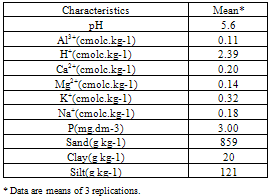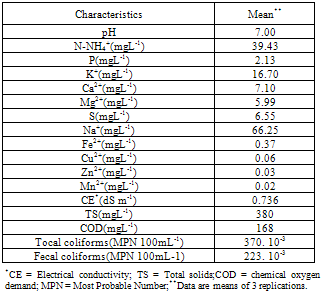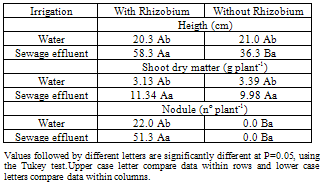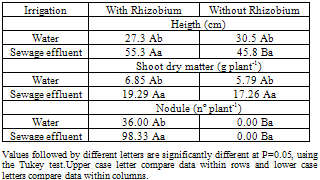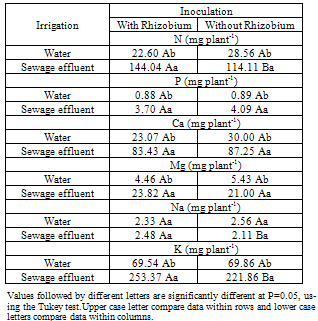-
Paper Information
- Next Paper
- Previous Paper
- Paper Submission
-
Journal Information
- About This Journal
- Editorial Board
- Current Issue
- Archive
- Author Guidelines
- Contact Us
International Journal of Agriculture and Forestry
p-ISSN: 2165-882X e-ISSN: 2165-8846
2012; 2(1): 72-78
doi:10.5923/j.ijaf.20120201.12
Effect of Irrigation with Sewage Effluent and Rhizobia Inoculation on Growth of Tropical Tree Legumes in Northeast Brazil
Fabíola G. de Carvalho1, Apolino J. N. da Silva2, Henio N. de S. Melo3, Josette L. de S. Melo3
1Diretoria Acadêmica de Recursos Naturais, Instituto Federal de Educação, Ciência e Tecnologia do Rio Grande do Norte,
2Av. Senador Salgado Filho, 1559, Tirol, CEP 59015-000, Natal, RN, Brasil
3Unidade Acadêmica Especializada em Ciências Agrárias Escola Agrícola de Jundiaí, Universidade Federal
Correspondence to: Apolino J. N. da Silva, Av. Senador Salgado Filho, 1559, Tirol, CEP 59015-000, Natal, RN, Brasil.
| Email: |  |
Copyright © 2012 Scientific & Academic Publishing. All Rights Reserved.
The use of domestic sewage in the agriculture is an alternative for reduction of the pollution of rivers, preservation of resources hydrics and availability of water and nutritious for plants. An experiment was conducted to investigate the effects of irrigation with sewage effluent and rhizobia inoculation on growth parameters and macro and micronutrients contents in shoots of leguminous trees grown in an Alisol in northeastern Brazil. Irrigation with sewage effluent and rhizobium inoculation affected significantly the growth parameters and nodulation of L. leucocephala and M. caesalpiniaefolia. Statistically higher values of shoot dry matter and plant height were observed in leguminous trees irrigated with sewage effluent, compared to treatment with water irrigation.Sewage effluent irrigation treatment also increased significantly the contents of N, P, K, Ca, Mg, Fe, Zn and Mn in shoots of woody legumes studied after harvest. Inoculation with Rhizobium promoted significant increases in growth parameters and macro and micronutrients contents, only when associated with application of sewage effluent.
Keywords: LeucaenaLeucocephala, Mimosa Caesalpiniaefolia, Shoot Dry Matter, Macronutrients, Micronutrients, Tropical Soils
Cite this paper: Fabíola G. de Carvalho, Apolino J. N. da Silva, Henio N. de S. Melo, Josette L. de S. Melo, Effect of Irrigation with Sewage Effluent and Rhizobia Inoculation on Growth of Tropical Tree Legumes in Northeast Brazil, International Journal of Agriculture and Forestry, Vol. 2 No. 1, 2012, pp. 72-78. doi: 10.5923/j.ijaf.20120201.12.
Article Outline
1. Introduction
- The need to preserve the resources hydrics and the liberation of waters of better quality for nobler uses, as the domestic supply, impelled the use of several types of wastewater in agriculture[31].Sanitary sewage presents great threat to the environment when inadequately thrown in water bodies. However, they can be treated and used in the agriculture without causing environmental risks or transmission of diseases[17].The treated wastewater irrigation is expected to gain increased importance, requiring careful considerations involving the adequate balance between nutritional inputs via irrigation and optimal plant productivity requirements[24]. Aside from economical benefits acquired for diverse climatic and soil conditions, crop irrigation with treated sewage effluents constitutes an ecologically sound method for the disposal of effluents into the environment[39]. The use ofsewage effluent irrigation in irrigated agriculture has been studied in various cultures[2,23,26,30]. Forage plants has been chosen for irrigation with sewage effluent because of the long growing season associated with high nutrient uptake capacity and the ability to prevent erosion processes[16]. Some studies show increases in growth parameters such as dry matter and plant height: alfalfa[19]; ‘Tifton 85’ hybrid bermudagrass[16]; bermudagrass[19] and forage corn[28]. For maize increases in dry matter[4] and silage yield[29] were observed after sewage effluents irrigation.Several leguminous trees are used as forages, and studies of the literature report its ability to N2-fixation by symbiosis with Rhizobium[10,11,18]. The tropical legume leucena (Leucaenaleucocephala) and sabiá (Mimosa caesalpiniaefolia) are multipurpose tree and are used for animal forage, wood production, fuel production, reforestation, stakes and coal, being adapted to semi-arid tropical regions of the Brazil[22,36,37]. However, there is a general lack of information regarding the effects of irrigation with sewage effluent on the growth parameters and nutrient uptake of woody legumes.The aim of this study was to evaluate the effect of the application of sewage effluent and rhizobia inoculation on growth parameters and nutrient uptake of leguminous trees.
2. Materials and Methods
2.1. Plant and Soil Characteristics
- The study was carried out in the region of the coastal tablelands, in the UFRN Experimental Station of Treatment of Sewages, in Natal city, Rio Grande do Norte State, Brazil. The soil used were a Yellow Red Argisoil in the Brazilian System of Soil Classification[13], corresponding to an Alisol in FAO legend[15], collected in area of degraded pasture, located in the Rockfeller farm, municipality of São Gonçalo do Amarante, Rio Grande do Norte State, Brazil. The soil mineralogy is characterized by minerals of variable charge, with <7% iron oxides and presence of kaolinite in the clay fraction. The chemical and physical characteristics of the studied soil are listed in the Table 1. The mean annual temperature of the studied area is 26℃ and the average annual rainfall is [21].
|
2.2. Plant Inoculation and Experimental Conditions
- The legumes L. leucocephalaand M. caesalpiniaefolia were planted in plastic pots (), each filled with of soil (0- layer), being made, 40 days before the planting, the application of lime and fertilization with phosphorus, following recommendation for tree legumes for the State of Pernambuco, Brazil[20].Treatments consisted of legumes irrigated with water and inoculated with rhizobium; legumes irrigated with domestic sewage effluent and inoculated with rhizobium; legumes irrigated with water and without inoculation; and legumes irrigated with domestic sewage effluent and without inoculation.The rhizobium strains used in the research for inoculation were furnished by the Company of Brazilian Agricultural Research (EmbrapaAgrobiologia).Seeds were surface- sterilised with 95% ethanol for 10 min, washed six times with sterilized water and soaked overnight to imbibe water. Seedlings of L. leucocephala were inoculated with Bradyrhizobium strains (BR 825 and BR 827) and M. caesalpiniaefolia with Bradyrhizobium strains (BR 3407 and BR 3446). After the incubation period, soil moisture was kept at 80% of field capacity throughout the experiment, in the areas irrigated with water and with the domestic sewage effluent, through a drip irrigation system, and using lateral plastic drains in the pots.The pots were distributed in two areas with dimensions of 3,5m x 3,5m, arranged in a completely randomized factorial design with 3 replications. In the first area the pots were irrigated with water and in the second area the pots were irrigated with domestic sewage effluent, originating from UFRN Station of Anaerobic Treatment of Sewages. The amount and frequency of irrigation were the same for every treatment and both crops. The amount of irrigation was 3 mm/day from planting to harvest the plants. Table 2 shows the chemical and microbiological characteristics of sewage effluent used in the experiment[27].
|
2.3. Statistical Analyses
- The statistical calculations were performed using the ASSISTAT software[34].The results were submitted to analysis of variance (ANOVA) using a completely randomized arrangement and 3 replications. The means were compared by the Tukey’s test, considering a significance level of p<0.05 throughout the study. Data accumulated N and number of nodules were submitted to regression and equations were obtained using Table Curve 2D software, Version 2.0.
3. Results and Discussion
3.1. Plant Growth and Nodulation
- Responses in height, shoot dry matter and nodulation by L. leucocephala and M. caesalpiniaefolia following application of sewage effluent and inoculation with rhizobia are presented in tables 3 and 4 respectively.
|
|
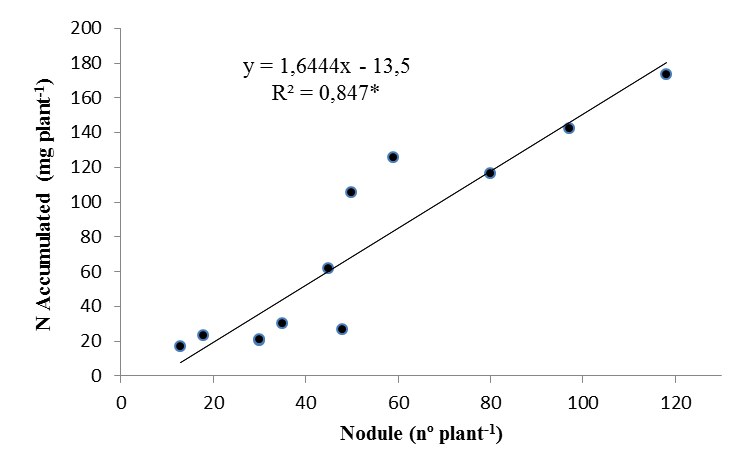 | Figure 1. Linear regression of N accumulated in shoot dry matter and nodule number of L. leucocephala and M. caesalpiniaefolia |
3.2. Macronutrients Accumulation
- The accumulation of N, P, Na and K in shoot dry matter of L. leucocephala was not significantly influenced by rhizobialinoculation (P<0.05), in the treatments irrigated with waters and with sewage effluent (Tables 5). Leucaenaleucocephala, however, accumulated larger values of Ca (51.92 mg plant-1) and Mg (14.34 mg plant-1) when inoculated with rhizobia and when irrigated with sewage effluent.The shoot dry matter N, Na and K content were significantly larger when M. caesalpiniaefolia was inoculated with rhizobia, and when plants were irrigated with sewage effluent.However, when irrigated with water, inoculation with rhizobia produced no response in N, P, Ca, Mg, Na and K level in shoots of M. caesalpiniaefolia, compared with the treatment without inoculation (Table 6).
|
|
3.3. Micronutrients Accumulation
- L. leucocephala inoculated with rhizobium presented values significantly higher of Zn, Fe and Mn accumulated in shoot dry matter, in relation to treatment without inoculation, in the soil irrigated with sewage effluent (Table 7), which may have occurred due to increased absorption of these micronutrients, reflecting the greater availability near the rhizosphere.Malavolta[25] emphasizes that when the source of N for the plant is atmospheric N2 fixed, there is a greater uptake of cations compared to anions, causing increased excretion of H+ and reduction of rhizosphere pH, which increases the availability of cationic micronutrients and the subsequent absorption by plants.In relation to the M. caesalpiniaefolia, rhizobium inoculation had no significant effect on contents of the micronutrients Cu, Zn and Fe in the shoot. Only the Mn content increased significantly in response to rhizobium inoculation, in soil irrigated with sewage effluent (Table 8). This may be attributed to differences in absorption of nutrients by plant species, due to variation in pH of the rhizosphere resulting from biological fixation of nitrogen by different species, promoting large variation in the availability of nutrients in the soil[32].When irrigated with water, the values of Cu, Zn, Fe and Mn in shoot dry matter of L. leucocephala and M. caesalpiniaefolia (Tables 7 and 8, respectively) were not affected for the inoculation with rhizobia.Application of sewage effluent increased significantly the contents of Zn, Fe and Mn in shoot dry weights of L. leucocephala and M. caesalpiniaefolia (Tables 7 and 8, respectively), compared to treatment with water irrigation, in both treatments with and without inoculation, probably reflects the increase of these micronutrients in the soil due to application of the effluent. The Cu content remained unchanged in response to application of the sewage effluent. Rattan et al.[30] also reported an increase of Zn, Fe and Mn in the dry matter of maize irrigated with sewage effluent, compared with soil irrigated with well water. Al- Nakshabandi et al.[5] observed higher concentrations of Cu, Fe, Mn, Pb and Zn in soil due to high concentration of these micronutrients in the treated sewage effluents. Similarly, Siebe[33] also found slight increases in Cd, Cu and Zn in soils cropped with alfalfa and irrigated with treated sewage effluents for more than 80 years.
|
4. Conclusions
- The results of this study indicate that application of sewage effluent increased the growth parameters (shoot dry matter and plant height) and nodulation of leguminous trees. With the exception of Na, macronutrients contents increased in shoot dry matter of woody legumes with the application of sewage effluent. Micronutrient contents (except for Cu) in the dry biomass of both legumes L. leucocephala and M. caesalpiniaefolia also increased with sewage effluent irrigation. Consequently, sewage effluent was efficient to improve plant growth and can be used as an alternative hydric resource in the cultivation of leguminous trees.The results also show that inoculation with Rhizobium promoted significant increases in growth parameters, macro- and micronutrients contents, only when associated with application of sewage effluent.In conclusion, this study indicated that treated sewage effluent can be used both as a potential source of nutrients such as water supply for tree legumes, however, suggest a continuous monitoring of the effluent quality, in order to determine the residual effects of treated sewage effluent before using it as a fertilizer.
ACTKNOWLEDGEMENTS
- The authors are grateful to the financial support of the Fundação de Apoio à Pesquisa do Estado do Rio Grande do Norte (FAPERN), the Conselho Nacional de Desenvolvi- mento Científico e Tecnológico (CNPq) by Research Grant, and to the logistic support of the Universidade Federal do Rio Grande do Norte (UFRN).
References
| [1] | Aghtape, A.A., Ghanbari, A., Sirousmehr, A., Siahsar, B., Asgharipour, M., Abolfazl, T., 2011, Effect of irrigation with wastewater and foliar fertilizer application on some forage characteristics of foxtail millet (Setariaitalica). International Journal of Plant Physiology and Biochemistry, 3, 34-42 |
| [2] | Akponikpèa, P.B.I., Wimab, K., Yacoubab, H., Mermoudc. A., 2011, Reuse of domestic wastewater treated in macrophyte ponds to irrigate tomato and eggplant in semi-arid West-Africa: Benefits and risks. Agricultural Water Management, 98, 834-840 |
| [3] | Al-Fredan, M., 2006, Effect of treated municipal waste water and rhizobia strains on growth and nodulation of faba bean (Viciafaba L. cv. Hassawi). Pakistan Journal of Biological Sciences,9, 1960-1964 |
| [4] | Al-Jaloud, A.A., Hussain, G., Al-Saati, A.J., Karimulla, S., 1995, Effect of wastewater irrigation on mineral composition of corn and sorghum plants in a pot experiment. Journal ofPlant Nutrition, 18, 1677-1692 |
| [5] | Al-Nakshabandi, G.A., Saqqar, M.M., Shatanawi, M.R., Fayyad, M., Al-Horani, H., 1997,Some environmental problems associated with the use of treated wastewater for irrigation in Jordan. Agricultural Water Management, 34, 81-94 |
| [6] | Azevedo, L.P., Oliveira, E.L., 2005, Efeitos da aplicação de efluente de tratamento de esgoto na fertilidade do solo e produtividade de pepino sob irrigaçãosubsuperficial. Engenharia Agrícola, 25, 253-263 |
| [7] | Bala, A., Murphy, P.J., Osunde, A.O., Giller, K.E., 2003, Nodulation of tree legumes and the ecology of their native rhizobial populations in tropical soils. Applied Soil Ecology, 22, 211-223 |
| [8] | Bezerra, L.J.D., Lima, V.L.A., Andrade, A.R.S., Alves, V.W., Azevedo, C.A.V.,Guerra, H.O.C., 2005, Analise de crescimento do algodão colorido sob os efeitos da aplicação de água residuária e biossólidos. Revista Brasileira de Engenharia Agrícola e Ambiental, 10, 333-338 |
| [9] | Chong, K., Wynne, J.C., Elkan, G.H., Schneeweis, M., 1987, Effects of soil acidity and aluminium content, growth and nitrogen fixation of peanuts and other grain legumes. Tropical Agriculture, 64, 97-104 |
| [10] | Daudin, D., Sierra, J., 2008, Spatial and temporal variation of below-ground N transfer from a leguminous tree to an associated grass in an agroforestry system. Agriculture Ecosystems and Environment, 126, 275-280. |
| [11] | David, S., Raussen, T., 2003,The agronomic and economic potential of tree fallows on scoured terrace benches in the humid highlands of Southwestern Uganda.Agriculture Ecosystems and Environment, 95, 359-369 |
| [12] | EMBRAPA - Empresa Brasileira de Pesquisa Agropecuária. Manual de análises de solos, plantas e fertilizantes. Embrapa Solos., 1999, Brasília: Embrapa Comunicação para Transferência de Tecnologia, 370p |
| [13] | EMBRAPA - Empresa Brasileira de Pesquisa Agropecuária. Sistema brasileiro de classificação de solos, 2006,SPI, Brasília, Brasil, 412 p. [20] |
| [14] | Falkiner, R.A., Smith, C.J., 1997, Changes in soil chemistry in effluent irrigated Pinusradiata and Eucalyptus grandis.Australian Journal of Soil Research, 35, 1997, 131-147 |
| [15] | FAO., 1988, Soil Map of the World. Revised legend. World Soils Resources Report 60, Food and Agriculture Organization of the United Nations. Rome |
| [16] | Fonseca, A.F., Melfi, A.J., Monteiro, F.A., Montes, C.R., Almeida, V.V., Herpin, U., 2007, Treated sewage effluent as a source of water and nitrogen for Tifton 85 bermudagrass. Agricultural Water Management, 87, 328-336 |
| [17] | Fonseca, A.F., Melfi, A.J., Montes, C.R., 2005, Maize growth and changes in soil fertility after irrigation with treated sewage effluent. II. Soil acidity, exchangeable cations, and sulfur, boron and heavy metals availability. Communications in Soil Science and Plant Analysis, 36, 1983-2003 |
| [18] | Gehring, C., Vlek, P.L.G., Souza, L.A.G., Denich, M., 2005, Biological nitrogen fixation in secondary regrowth and mature rainforest of central Amazonia. Agriculture Ecosystems and Environment, 111, 237-252 |
| [19] | Grattan, S.R., Grieve, C.M., Poss, J.A., Robinson, P.H., Suarez, D.L., Benes, S.E., 2004, Evaluation of salt-tolerant forages for sequential water reuse systems. I. Biomass production. Agricultural Water Management, 70, 109-120 |
| [20] | IPA – Empresa Pernambucana de Pesquisa Agropecuária. Cavalcanti, F. J. A. C. (Coord.). Recomendação de adubação para o Estado de Pernambuco 2° aproximação. Recife: IPA, 1998. 198 p |
| [21] | Jacomine, P.K.T., Silva, F.B.R., Formiga, R.A., Almeida, J.C., Beltrão, V. A., Pessôa, S.C.P., Ferreira, R.C., 1971, Levantamento Exploratório - Reconhecimento de Solos do Estado do Rio Grande do Norte. Recife: SUDENE-DRN, 531p. (Boletim Técnico, 21) |
| [22] | Jube, S.L.R., Borthakur, D., 2010, Transgenic Leucaenaleucocephala expressing the Rhizobium gene pydA encoding a meta-cleavage dioxygenase shows reduced mimosine content. Plant Physiology and Biochemistry, 48, 273-278 |
| [23] | Kiziloglu, F.M., Turan, M.,, Sahin, U.,Kuslu, Y., Dursun, A., 2008, Effects of untreated and treated wastewater irrigation on some chemical properties of cauliflower (Brassica olerecea L. var. botrytis) and red cabbage (Brassica olerecea L. var. rubra) grown on calcareous soil in Turkey. Agricultural Water Management, 95, 716-724 |
| [24] | Leal, R.M.P., Firme, L.P., Montes, C.R., Melfi, A.J., Piedade, S.M.S., 2009, Soil exchangeable cations, sugarcane production and nutrient uptake after wastewater irrigation. Scientia Agricola, 66, 242-249 |
| [25] | Malavolta, E., 2006, Manual de nutrição mineral de plantas. Editora Agronômica Ceres. São Paulo, 638 pp |
| [26] | Medeiros, S.S., Soares, A.A., Ferreira, P.A., Neves, J.C.L., Souza, J.A., 2008, Utilização de água residuária de origem doméstica na agricultura: Estudo do estado nutricional do cafeeiro. Revista Brasileira de Engenharia Agrícola e Ambiental, 12, 109-115 |
| [27] | Melo, H. N. S., Miranda, R. J. A., Moura, L.R.B.,Melo Filho, C.P., Andrade Neto, C. O., Lucas Filho, M., 2002,II-082 – Hidroponia com esgoto tratado – Técnica do filme nutriente. VI Simpósio Ítalo Brasileiro de Engenharia Sanitária e Ambiental. Associação Brasileira de Engenharia Sanitária e Ambiental (ABES) |
| [28] | Mohammad, M.J., Ayadi, M., 2004, Forage yield and nutrient uptake as influenced by secondary treated wastewater. Journal of Plant Nutrition, 27, 351-364 |
| [29] | Overman, A.R., 1981, Irrigation of corn with municipal effluent. Transactions of the American Society of Agricultural Engineers, 24, 74-80 |
| [30] | Rattan, R.K., Datta, S.P., Chhonkar, P.K., Suribabu, K., Singh, A.K., 2005, Long-term impact of irrigation with sewage effluents on heavy metal content in soils, crops and groundwater—a case study.Agriculture Ecosystems and Environment, 109, 310–322 |
| [31] | Rogers, M., Smith, S. R., 2007, Ecological impact of application of wastewater biosolids to agricultural soil. Water Environment Journal, 21, 34–40 |
| [32] | Römheld, V., 1986PH changes in the rhizosphere of various crop plants in relation to the supply of plant nutrients. Potash Review, 12, 1-12. [37] |
| [33] | Siebe, C., 1995, Heavy metal availability to plants in soils irrigated with wastewater from Mexico City. Water Science and Technology, 32, 29-34 |
| [34] | Silva, F.A.S.E., 1996, The ASSISTAT Software: statistical assistance. In: INTERNATIONAL CONFERENCE ON COMPUTERS IN AGRICULTURE, 6., Cancun, 1996. Anais. Cancun, American Society of Agricultural Engineers, p.294-298 |
| [35] | Souza, L.A.G., BezerraNeto, E., Santos, C.E.R.S., Stamford, N.P., 2007, Development and natural nodulation of legume trees in soils from Pernambuco, Brazil. PesquisaAgropecuáriaBrasileira, 42, 207-217 |
| [36] | Stamford, N.P., AraújoFilho, J.T., Silva, A.J.N., 2000, Growth and nitrogen fixation of Leucaenaleucocephala and Mimosa caesalpiniaefolia in a saline soil of the Brazilian semi-arid region as affected by sulphur, gypsum and saline water. Tropical Grasslands, 34, 1-6 |
| [37] | Stamford, N.P., Silva, A.J.N., Freitas, A.D.S., AraújoFilho, J.T., 2002, Effect of sulphur inoculated with Thiobacillus on soil salinity and growth of tropical tree legumes. Bioresource Technology, 81, 53-59 |
| [38] | Stamford, N.P., Silva, R.A., 2000, Efeito da calagem e inoculação de sabiá em solo da mata úmida e do semi-árido de Pernambuco. Pesquisa Agropecuária Brasileira, 35, 1037- 1045 |
| [39] | Toze, S., 2006, Reuse of effluent water – benefits and risks. Agricultural Water Management, 80, 147-159 |
 Abstract
Abstract Reference
Reference Full-Text PDF
Full-Text PDF Full-text HTML
Full-text HTML